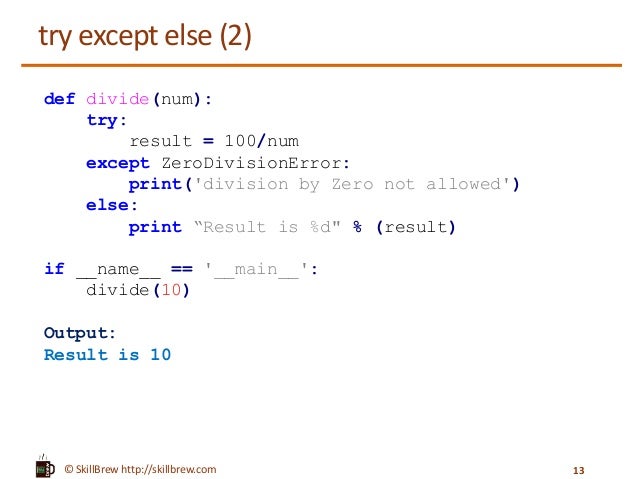

We can see that syntax error occurs in the program when we use more general except block before the specific exceptions. Synta圎rror: default 'except:' must be last Runfile('/home/aditya1117/untitled0.py', wdir='/home/aditya1117')įile "/usr/lib/python3/dist-packages/spyder_kernels/customize/spydercustomize.py", line 827, in runfileįile "/usr/lib/python3/dist-packages/spyder_kernels/customize/spydercustomize.py", line 110, in execfileĮxec(compile(f.read(), filename, 'exec'), namespace)įile "/home/aditya1117/untitled0.py", line 8 try:įile "/usr/lib/python3/dist-packages/IPython/core/interactiveshell.py", line 3331, in run_codeĮxec(code_obj, er_global_ns, er_ns)
#Try catch python code#
Otherwise unreachable code will be generated and will cause error.įor example, following way of using try-except in python to differentiate exceptions is wrong. One has to be kept in mind while differentiating exceptions is that the most general exception has to be written last in the except block and most specific exception has to be written first in the except block. In the above program, we have explicitly differentiated AssertionError, ValueError and NameError from other types of exceptions and we have handled them explicitly. So, we will use try-except error handling code to raise an error manually when age is negative and then we will show the proper output as follows. In the above output, we can see that the program has executed successfully and has given an output which is logically impossible because no person can have his year of birth in future. Now we will try to give a negative age as input to the program and see what happens. We can see that the program has given correct output for a person of age 10.

Hence we may use raise keyword to throw exceptions in the python try-except block to enforce the constraints.įor example, suppose we want to calculate the year of birth of a person from their age, we can do it as following: Here the point to keep in mind is that a program may not throw any error but it may give an unrealistic value as output when proper constraints are not applied on the variables. By throwing inbuilt exceptions using raise keyword, we can use the inbuilt exceptions to enforce constraints on the variables to make sure that program is correct logically. Raising Exceptions Manually using raise keywordĪ python program throws inbuilt exceptions automatically when an error occurs but we can also raise inbuilt exceptions manually using raise keyword. In this article, we will look at some ways to write an efficient python program by looking at illustrations to best use try-except in python.So, let’s dive into it. In python, we use try-except blocks to implement exception handling.

Exception handling allows us to enforce constraints on variables to implement our business logic in the computer program and it also enables us to write a robust program which can handle different types of errors occurred during execution.


 0 kommentar(er)
0 kommentar(er)
